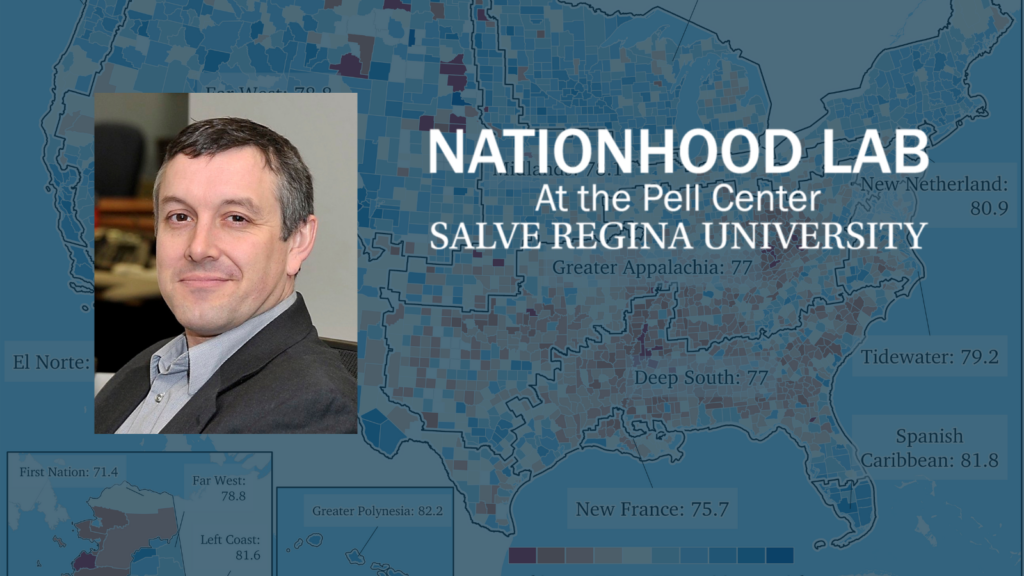Woodard Publishes Sweeping Analysis of Regional Differences in Life Expectancy in U.S.
September 1, 2023
NEWPORT, RI— New analysis of U.S. life expectancy data found dramatic regional differences between the centuries-old regional cultures that make up the country, with people in southern regions living three, four, or nearly five years shorter than Americans in regions to their north and west.
The analysis, published late Thursday by Nationhood Lab at Salve Regina University’s Pell Center for International Relations and Public Policy, examined county-level life expectancy estimates for the period 2018-2020 using the American Nations regional model. The American Nations model designates regions based on the mapping of rival colonization streams and is more accurate than designating regions based on often arbitrary state lines. It is the subject of a magazine length Politico article by Nationhood Lab director Colin Woodard that published Friday morning.
The gaps between the regional cultures were comparable to those separating gap the U.S. and Bulgaria, Libya, and the Philippines. In some comparisons – such as Left Coast (the Pacific coastal plain north of Monterey, California) and First Nation (the parts of Alaska where indigenous culture, though damaged, remains dominant on the ground) – the differences were more than a decade, comparable to the gulf between Japan and Peru.
The Deep South and the sprawling Greater Appalachia region had an overall life expectancy of 77 years during this period, similar to Albania’s in 2020, while in the Left Coast the figure was 81.6, which about the same as Canada’s. The differences between some of the smaller “enclaves” – small extensions of regional cultures that primarily exist outside the present borders of the U.S. – were even greater, with the gap between Hawaii (part of Greater Polynesia) and First nation standing at a staggering 10.8 years.
“It’s as if we are living in different countries,” Woodard said. “Because in a very real historical and political sense, we are.”
Public health experts said they findings were consistent with what researchers have seen for decades with life expectancy and the prevalence of obesity, stroke, diabetes, inactivity, stroke, gun deaths and other factors.
“It’s no big surprise when you look at county-level data that the southern regions have higher prevalence of these things, but never has the relationship been so clean as with the American Nations settlement maps,” says Ross Arena, a physiologist at the University of Illinois-Chicago who studies the health effects of exercise and co-authored academic journal articles with Nationhood Lab on regional health differences. “With the American Nations it became clear that these issues are not bound by state and that a big piece of this may be culture.”
The gaps persisted when the data was parsed by race and by comparing just counties that were rural or urban, rich or poor, educated or not, or had really good or really bad access to clinical care, though with a few revealing shifts in the ranking order.
One of the most arresting findings was that life expectancy in the most impoverished set of counties in Yankeedom (the section of the northeast first colonized by New England Puritans and their descendants), New Netherland (the Dutch-founded culture around today’s New York City) and the Left Coast was higher than in the least impoverished set of counties in the Deep South.
The full report can be seen at the Nationhood Lab project’s website. It is built on the American Nations model of regional cultures developed in Woodard’s 2011 book, American Nations: A History of the Eleven Rival Regional Cultures of North America.
Nationhood Lab, based at the Pell Center for International Relations and Public Policy at Salve Regina University, is an interdisciplinary research, writing, testing and dissemination project focused on counteracting the authoritarian threat to American democracy and the centrifugal forces threatening the federation’s stability. The project delivers more effective tools with which to describe and defend the American liberal democratic tradition and better understand the forces undermining it.

